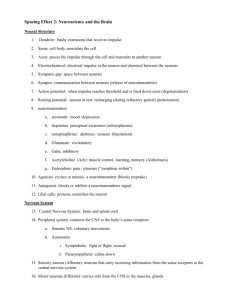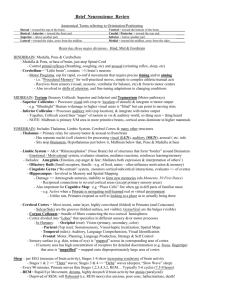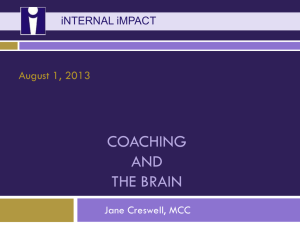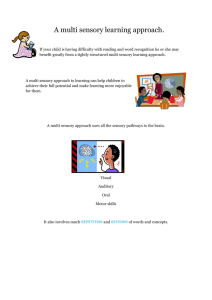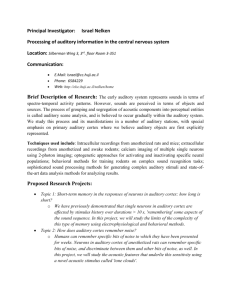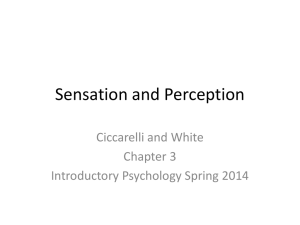Multi-Sensory Neurons
advertisement
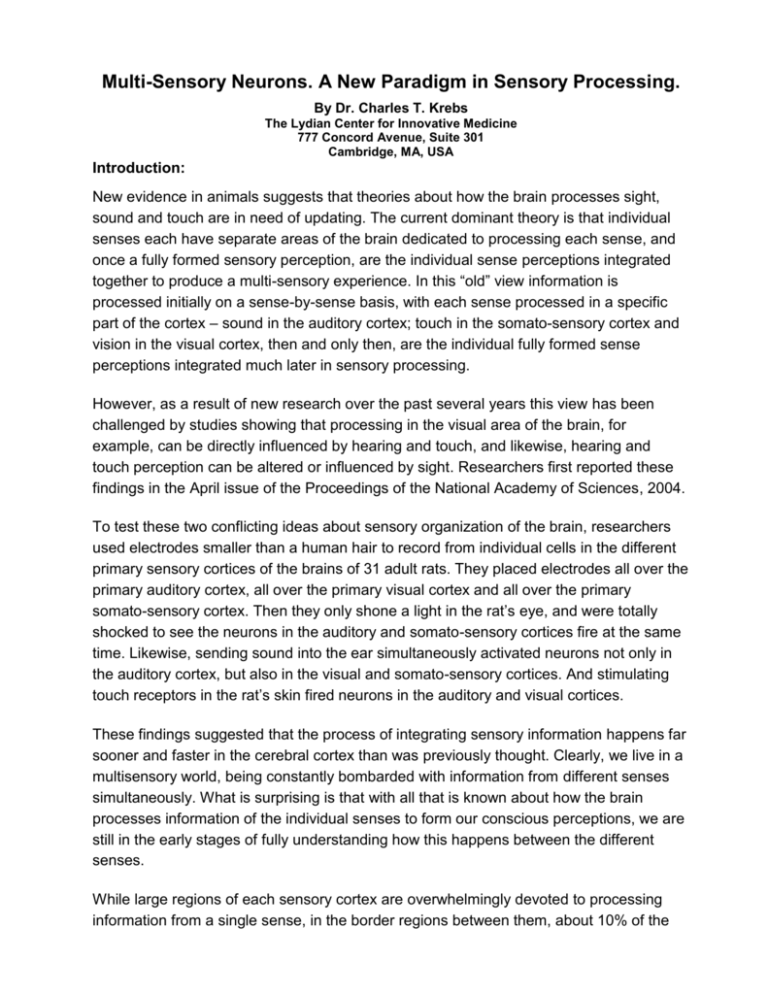
Multi-Sensory Neurons. A New Paradigm in Sensory Processing. By Dr. Charles T. Krebs The Lydian Center for Innovative Medicine 777 Concord Avenue, Suite 301 Cambridge, MA, USA Introduction: New evidence in animals suggests that theories about how the brain processes sight, sound and touch are in need of updating. The current dominant theory is that individual senses each have separate areas of the brain dedicated to processing each sense, and once a fully formed sensory perception, are the individual sense perceptions integrated together to produce a multi-sensory experience. In this “old” view information is processed initially on a sense-by-sense basis, with each sense processed in a specific part of the cortex – sound in the auditory cortex; touch in the somato-sensory cortex and vision in the visual cortex, then and only then, are the individual fully formed sense perceptions integrated much later in sensory processing. However, as a result of new research over the past several years this view has been challenged by studies showing that processing in the visual area of the brain, for example, can be directly influenced by hearing and touch, and likewise, hearing and touch perception can be altered or influenced by sight. Researchers first reported these findings in the April issue of the Proceedings of the National Academy of Sciences, 2004. To test these two conflicting ideas about sensory organization of the brain, researchers used electrodes smaller than a human hair to record from individual cells in the different primary sensory cortices of the brains of 31 adult rats. They placed electrodes all over the primary auditory cortex, all over the primary visual cortex and all over the primary somato-sensory cortex. Then they only shone a light in the rat’s eye, and were totally shocked to see the neurons in the auditory and somato-sensory cortices fire at the same time. Likewise, sending sound into the ear simultaneously activated neurons not only in the auditory cortex, but also in the visual and somato-sensory cortices. And stimulating touch receptors in the rat’s skin fired neurons in the auditory and visual cortices. These findings suggested that the process of integrating sensory information happens far sooner and faster in the cerebral cortex than was previously thought. Clearly, we live in a multisensory world, being constantly bombarded with information from different senses simultaneously. What is surprising is that with all that is known about how the brain processes information of the individual senses to form our conscious perceptions, we are still in the early stages of fully understanding how this happens between the different senses. While large regions of each sensory cortex are overwhelmingly devoted to processing information from a single sense, in the border regions between them, about 10% of the neurons receive input from two senses: about 10% of auditory neurons also process visual input, 10% of somato-sensory neurons process visual information as well, while about 10% of visual neurons also receive auditory information, and another 10% of visual neurons in another area in the visual cortex receives somato-sensory input. The discovery of multi-sensory neurons represents a new view of how the brain is actually organized, and helps explain how individuals who suffer a loss of one sense early in their life often develop greater acuity in their remaining senses. Imaging studies in humans show that when sight is lost at a young age, a portion of the visual cortex that had been dedicated to sight begins to process sound and another region of the visual cortex begins to process touch. Indeed, when an area of a sensory cortex does not receive any input from the normal receptors associated with that sense – e.g. you are blind, the multi-sensory neurons of that cortex “take over” much of the area that would have been devoted to the normal sense whose receptors have been damaged. For instance, when a person is born blind or loses his/her vision early in life, the multisensory neurons of the auditory cortex now usurp a huge area of the visual cortex that would have processed sight, and likewise, the multi-sensory neurons of the somatosensory cortex usurp other huge areas of the visual cortex that would also have processed sight. However, what the visual cortex does is make images! In the normal course of things these would be normal visual images, but with visual input lacking, and the sound and somato-sensory touch multi-sensory neurons taking over large parts of the visual cortex, you now have sound images formed and touch images formed, which the person can now use to accurately navigate their world almost as effectively as a sighted person can! Have you ever watched a blind person read Braille? There are several extreme examples of how these multi-sensory neurons can literally help the blind see. A seven-year-old boy blind from birth has been taught to "see" using his ears. Lucas Murray from Poole in Dorset, England, has learned to use echoes to picture the world around him - similar to sonar techniques used by bats and dolphins. He clicks his tongue on the roof of his mouth and from the sound that returns his brain makes a “sound picture” of his environment allowing him to work out the distance, shape, density and position of objects. The echolocation technique has helped Lucas play basketball and rock climb. He is able to click his tongue and determine where things are around him and what things are around him and he is able to travel comfortably without holding on to people. He even plays basketball, and is able to shoot the ball into the hoop by clicking, he is actually pretty good it. An American boy Ben Underwood lost both his eyes to cancer at age two, and likewise worked out this tongue clicking technique, and now plays video games on the TV by just listening to the sounds and turning them into pictures in his head, as well as rollerblading down the his street deftly avoiding cars and his friends on their rollerblades! The discovery of these multi-sensory neurons also shed light on an enigma that has resisted understanding for centuries – the phenomenon of Synesthesia – perception of one sense as another sense. Synesthesia occurs in about 4% of the human population to some degree. The most common form is hearing colors, “Oh, Susan, that’s a red name!”, but any combination of senses may be involved. One of the most unusual forms of synesthesia is experiencing tastes as tactile experience, which is so well described in Richard Cytowic’s excellent book, The Man Who Tasted Shapes. If the old dominant model of sensory integration, each type of sensory input (e.g. sight) was processed until it is a fully formed sensory perception and then integrated with another fully formed sensory perception (i.e. sound) were true, the multi-sensory experiences reported in synesthetes would appear impossible! But, if every sense is actually part of the processing of every other sense from the first firing of a sensory neuron bringing that information into the brain, we are all synesthetes, just subconscious synesthtes, as this early level of all sensory processing is totally subconscious. For some reason in “conscious synesthetes”, they become conscious of this normally subconscious processing? The more recent studies support early integration of sensory processing and have important implications for understanding Sensory Integration problems in children. If the senses interact at the very first step of sensory input, it may very well be possible for the input of one sense to “dis-integrate” or desynchronize the processing of the early stages of processing of another sense. And in computer terms – Garbage in, Garbage out! If the very first stages of sensory processing are disrupted by input of another sense, then this may result in the receiving sense being poorly integrated and cause difficulties at higher levels of integration like comprehension. The highest level of integration is conscious perception of a multisensory event, as all of the individual perceptions have to be integrated again at even a higher level. This is exactly what you see with children with sensory integration problems. Often their perception of individual senses is reasonably good. If you give them an auditory test of single frequencies – TOOT, BOOP, etc., they can integrate this single input and “hear” fine. If, however, you talk to them while there is any visual or tactile distracting activity, they often cannot “understand or comprehend” what they heard! It appears that the other distracting sense disrupts the sense they are now focusing on – hearing what you are saying to them. Interesting, sight seems to disrupt or disintegrate sound processing much more often than the other way around. Why? My hypothesis is the speed of processing. Light is first of all far faster than sound, 186,000 miles per second versus 770 feet per second, and hence its processing is always initiated first. Then once in the nervous system, sight is also processed more rapidly. There are far fewer neural links in the light pathways from the retina to the primary visual cortex than from the ear drum to the primary auditory cortex. In fact, the first step of light processing, absorption of a photon transduced into an action potential in the chromophore (pigment) of the retina, happens almost instantly. Then there are only the high-speed myelinated optic nerves, an outgrowth of the diencephalon, that only stop once, at the Lateral Geniculate Nucleus. From there it is only one more set of high-speed myelinated neurons, the optic radiations, back to the primary visual cortex where visual processing begins, and of course in the new model – where the visual multisensory neurons feed-forward a signal into the auditory cortex. This is long before the sound of the thing seen has even reached the ears! Compare this with sound perception where the first step is sound production is the sound wave being transduced mechanically to the movement of the eardrum, then transmitted mechanically by the ear bones to the oval window where the mechanical action creates a standing wave in the endolymph of the Scala vestibuli, which then mechanically depresses the tectorial membrane generating an action potential in the hair cell! Then the signal goes to a number of brainstem processing centres, the ventral and dorsal cochlear nuclei, the superior olivary complexes, the nucleus of the medial longitudinal fasciculi, and the inferior colliculi before even reaching the Medial Geniculate Nuclei from which they are transmitted to the primary auditory cortex. In contrast, while the auditory multisensory neurons do indeed send feed-forward input into the visual cortex, there has already been considerable initial visual processing completed before this potentially disruptive input from sound has arrived. Therefore, sound is much less likely to significantly interfere with vision than the other way around, and indeed this is what you see, many more children have auditory integration problems, and their hearing and auditory comprehension is much more often disturbed by visual input than visual input disturbed by auditory input. In fact, the new rage in diagnosis is called a “Central Auditory Processing Problem (CAPP) or Central Auditory Processing Disorder (CAPD)”, with some neurologists suggesting it may affect up to a third of all children today! Of course the most primary senses are somato-sensory processing, especially touch and proprioception, as both vision and hearing are built upon these most physical of senses – this is what is “real” in our world. Vision and sound are only mental representations of “real” things. For instance, the ease with which your eye can be deceived is because it only processing representations of things, not the actual things, and likewise, exactly what is actually making a sound and exactly where it is in space are often difficult for hearing – ever tried to find the bird in the tree that was singing? While you have a mental representation of a bird singing, it’s difficult to know which bird is actually singing, and sometimes even where it is singing! However, what something is or where it is, is never in doubt with the sense of touch and proprioception. This is the reason babies at first pay little attention to their visual or auditory worlds, but are totally focused on touch and learning about the movement of their body – proprioception. All of vision and hearing is based upon the initial linkage of sight to touch and proprioception and sound to touch and proprioception (proprioception is the physical location of your body parts in space from the body’s perspective). From these initial body centered experiences, the brain learns how to create mental representations of the world, and “scale-up” experiences to be able to project how far away from you something is that you cannot touch! This poor integration of these multisensory neurons may indeed be the basis of much of the sensory integration problems recognized in children today. Indeed, sensory integration issues are an apparently rapidly increasing problem. This should not be surprising as one of the primary behaviors children should be engaged in to develop the integration of their senses – Play, is almost totally absent in many children’s lives today! Sitting still looking into a fake 3-D world that you cannot physically touch or feel and moving your thumbs DOES NOT constitute PLAY! You are not integrating the connections between your senses which can only accurately developed by actually moving your body and repeatedly touching what you are looking at to gain two things: the relationship between the object you are looking at that may or may not be making a noise and your physical location in space! From these initial sensory experiences we build more complex and complete sensory experiences. First we reach for the brightly colored object making noise, and “learn” where in space it is relative to our body by how far we have to reach to touch it – the touch confirming the “real” location of the object and our proprioception – all of our muscle, tendon, ligament, and skin stretch receptors – where that “real” object is relative to our current physical location. Then as our experiences become more complex as we can now move around and engage our world more fully, and our brains become more developed, we can begin to “scale up” our experiences so we can begin to estimate where objects of interest are even when we can no longer actually touch them – e.g. that red ball is 3-arm lengths away from me! Lack of developing these physical sensory experiences results in sensory integration problems so prevalent today! But just consider the number of hours each day that “modern” children spend watching TV, and “playing” computer games – time that they used to use to actual “play” engaging their “real world” to develop their multi-sensory understanding of their world! Indeed, multi-sensory neurons were part of nature’s plan to facilitate the development our multi-sensory experience of our world!


